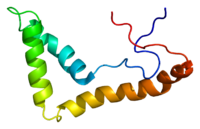
Photo from wikipedia
A de novo, pathogenic, missense variant in UBTF, c.628G>A p.Glu210Lys, has been described as the cause of an emerging neurodegenerative disorder, Childhood‐Onset Neurodegeneration with Brain Atrophy (CONDBA). The p.Glu210Lys alteration… Click to show full abstract
A de novo, pathogenic, missense variant in UBTF, c.628G>A p.Glu210Lys, has been described as the cause of an emerging neurodegenerative disorder, Childhood‐Onset Neurodegeneration with Brain Atrophy (CONDBA). The p.Glu210Lys alteration yields a positively charged stretch of three lysine residues. Functional studies confirmed this change results in a stronger interaction with negatively charged DNA and gain‐of‐function activity when compared to the wild‐type sequence. The CONDBA phenotype reported in association with p.Glu210Lys consists of normal early‐neurodevelopment followed by progressive motor, cognitive, and behavioral regression in early‐to‐middle childhood.
Journal Title: Molecular Genetics & Genomic Medicine
Year Published: 2022
Link to full text (if available)
Share on Social Media: Sign Up to like & get
recommendations!